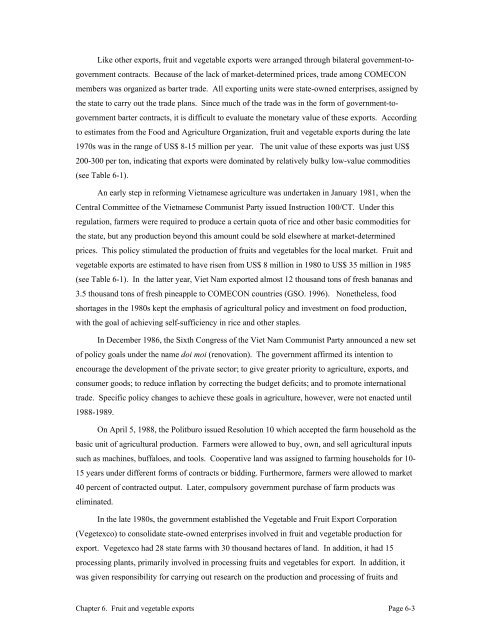Fruits and Vegetables in Vietnam - International Food Policy ...
Fruits and Vegetables in Vietnam - International Food Policy ...
Fruits and Vegetables in Vietnam - International Food Policy ...
Create successful ePaper yourself
Turn your PDF publications into a flip-book with our unique Google optimized e-Paper software.
Like other exports, fruit <strong>and</strong> vegetable exports were arranged through bilateral government-togovernment<br />
contracts. Because of the lack of market-determ<strong>in</strong>ed prices, trade among COMECON<br />
members was organized as barter trade. All export<strong>in</strong>g units were state-owned enterprises, assigned by<br />
the state to carry out the trade plans. S<strong>in</strong>ce much of the trade was <strong>in</strong> the form of government-togovernment<br />
barter contracts, it is difficult to evaluate the monetary value of these exports. Accord<strong>in</strong>g<br />
to estimates from the <strong>Food</strong> <strong>and</strong> Agriculture Organization, fruit <strong>and</strong> vegetable exports dur<strong>in</strong>g the late<br />
1970s was <strong>in</strong> the range of US$ 8-15 million per year. The unit value of these exports was just US$<br />
200-300 per ton, <strong>in</strong>dicat<strong>in</strong>g that exports were dom<strong>in</strong>ated by relatively bulky low-value commodities<br />
(see Table 6-1).<br />
An early step <strong>in</strong> reform<strong>in</strong>g <strong>Vietnam</strong>ese agriculture was undertaken <strong>in</strong> January 1981, when the<br />
Central Committee of the <strong>Vietnam</strong>ese Communist Party issued Instruction 100/CT. Under this<br />
regulation, farmers were required to produce a certa<strong>in</strong> quota of rice <strong>and</strong> other basic commodities for<br />
the state, but any production beyond this amount could be sold elsewhere at market-determ<strong>in</strong>ed<br />
prices. This policy stimulated the production of fruits <strong>and</strong> vegetables for the local market. Fruit <strong>and</strong><br />
vegetable exports are estimated to have risen from US$ 8 million <strong>in</strong> 1980 to US$ 35 million <strong>in</strong> 1985<br />
(see Table 6-1). In the latter year, Viet Nam exported almost 12 thous<strong>and</strong> tons of fresh bananas <strong>and</strong><br />
3.5 thous<strong>and</strong> tons of fresh p<strong>in</strong>eapple to COMECON countries (GSO. 1996). Nonetheless, food<br />
shortages <strong>in</strong> the 1980s kept the emphasis of agricultural policy <strong>and</strong> <strong>in</strong>vestment on food production,<br />
with the goal of achiev<strong>in</strong>g self-sufficiency <strong>in</strong> rice <strong>and</strong> other staples.<br />
In December 1986, the Sixth Congress of the Viet Nam Communist Party announced a new set<br />
of policy goals under the name doi moi (renovation). The government affirmed its <strong>in</strong>tention to<br />
encourage the development of the private sector; to give greater priority to agriculture, exports, <strong>and</strong><br />
consumer goods; to reduce <strong>in</strong>flation by correct<strong>in</strong>g the budget deficits; <strong>and</strong> to promote <strong>in</strong>ternational<br />
trade. Specific policy changes to achieve these goals <strong>in</strong> agriculture, however, were not enacted until<br />
1988-1989.<br />
On April 5, 1988, the Politburo issued Resolution 10 which accepted the farm household as the<br />
basic unit of agricultural production. Farmers were allowed to buy, own, <strong>and</strong> sell agricultural <strong>in</strong>puts<br />
such as mach<strong>in</strong>es, buffaloes, <strong>and</strong> tools. Cooperative l<strong>and</strong> was assigned to farm<strong>in</strong>g households for 10-<br />
15 years under different forms of contracts or bidd<strong>in</strong>g. Furthermore, farmers were allowed to market<br />
40 percent of contracted output. Later, compulsory government purchase of farm products was<br />
elim<strong>in</strong>ated.<br />
In the late 1980s, the government established the Vegetable <strong>and</strong> Fruit Export Corporation<br />
(Vegetexco) to consolidate state-owned enterprises <strong>in</strong>volved <strong>in</strong> fruit <strong>and</strong> vegetable production for<br />
export. Vegetexco had 28 state farms with 30 thous<strong>and</strong> hectares of l<strong>and</strong>. In addition, it had 15<br />
process<strong>in</strong>g plants, primarily <strong>in</strong>volved <strong>in</strong> process<strong>in</strong>g fruits <strong>and</strong> vegetables for export. In addition, it<br />
was given responsibility for carry<strong>in</strong>g out research on the production <strong>and</strong> process<strong>in</strong>g of fruits <strong>and</strong><br />
Chapter 6. Fruit <strong>and</strong> vegetable exports Page 6-3
















